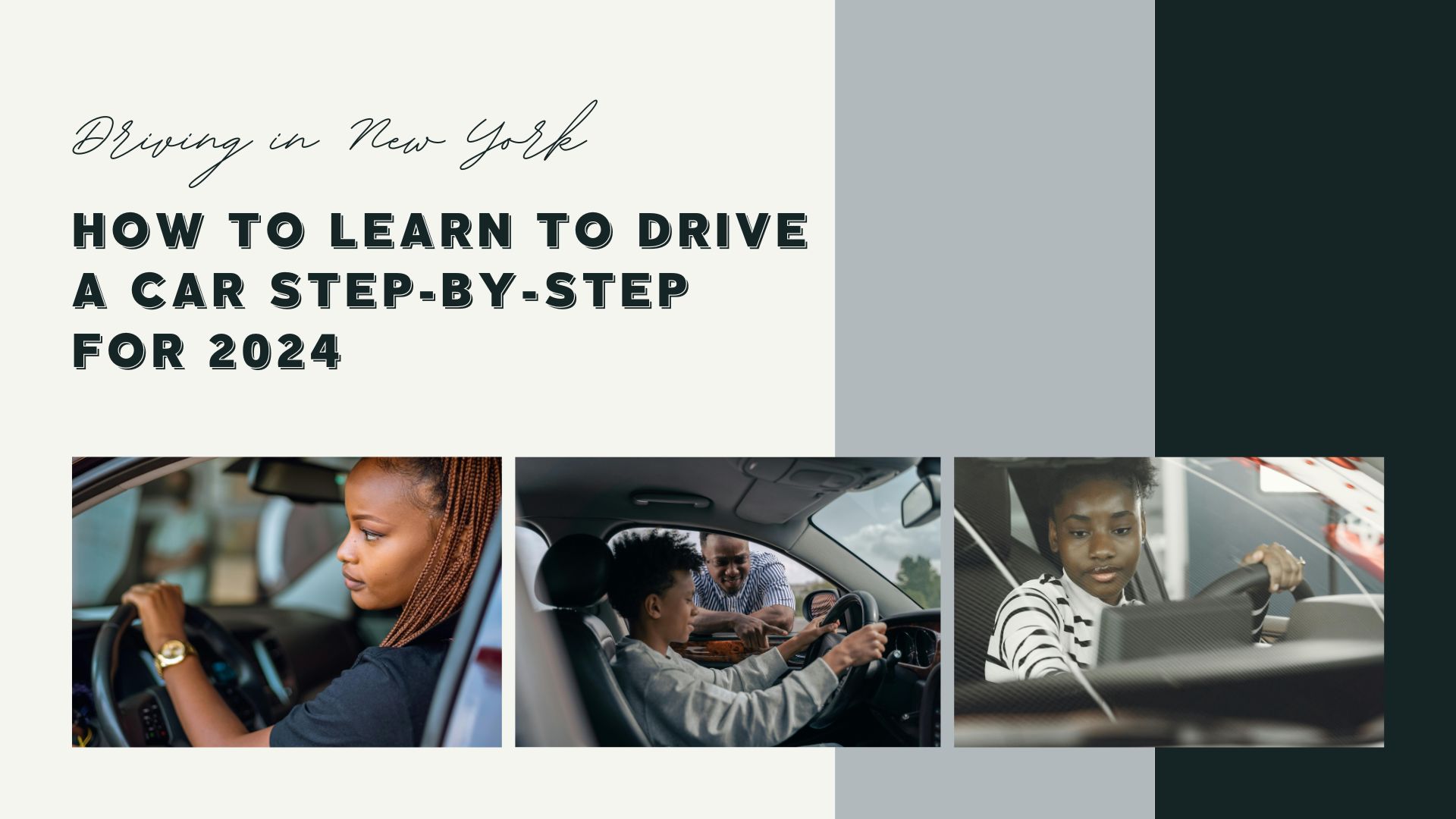How to Learn to Drive a Car Step-by-Step for 2024

Table of Contents
Learning to drive is an exciting milestone that opens up a world of freedom and independence. However, for many people, the process of learning how to drive can be overwhelming and intimidating. Whether you're a young adult or someone who has never had the opportunity to get behind the wheel, this comprehensive guide will walk you through the steps to become a confident and safe driver.
In this article, we'll cover everything from obtaining your learner's permit to mastering essential driving techniques and ultimately passing your driver's license test. We'll also discuss the differences between automatic and manual transmission vehicles, provide tips for finding the right driving instructor, and share strategies for overcoming common challenges faced by new drivers.
So, buckle up and get ready to embark on your journey to learning how to drive a car!
Gearing Up for the Road
Before you can start learning to drive, there are a few important steps you need to take:
Obtaining a Learner's Permit
The first step in learning how to drive is getting your learner's permit. The requirements and procedures for obtaining a permit vary by state, so be sure to check with your local Department of Motor Vehicles (DMV) for specific details. Generally, you'll need to:
- Meet the minimum age requirement (usually 15 or 16 years old)
- Pass a written knowledge test covering traffic laws and road signs
- Provide proof of identity and residency
- Pay the required fee
Choosing Between Automatic and Manual Transmission
When learning to drive, you'll need to decide whether you want to learn on an automatic or manual transmission vehicle. Here are some pros and cons of each:
|
Transmission Type |
Pros |
Cons |
|
Automatic |
Easier to learn and operate |
Limited control over the vehicle |
|
Smoother driving experience |
Slightly less fuel-efficient |
|
|
Manual |
More control over the vehicle |
Steeper learning curve |
|
Better fuel efficiency |
Can be challenging in stop-and-go traffic |
Finding the Right Driving Instructor
Choosing the right driving instructor is crucial to your success as a new driver. Look for an instructor who:
- Is experienced and fully qualified
- Has a good track record of teaching students
- Makes you feel comfortable and confident behind the wheel
- Offers a teaching style that suits your learning needs
Don't be afraid to ask for recommendations from friends or family members who have recently learned to drive, or to shop around and compare different driving schools before making a decision.
Mastering the Basics
Once you've obtained your learner's permit and found a qualified driving instructor, it's time to start mastering the basics of driving a car.
Getting Comfortable in the Driver's Seat
Before you start the engine, take a few moments to familiarize yourself with the vehicle and adjust everything to your liking:
- Adjust the seat so that you can comfortably reach the pedals and steering wheel
- Adjust the mirrors (rearview and side mirrors) for optimal visibility
- Locate the important controls, such as the turn signals, windshield wipers, and headlights
Understanding the Car's Controls
To learn how to drive, you must understand the function of each control in the car:
- Steering wheel: Controls the direction of the car
- Accelerator pedal: Controls the speed of the car
- Brake pedal: Slows down or stops the car
- Clutch pedal (manual transmission): Disengages the engine from the wheels when shifting gears
- Gear shift: Selects the car's gear (Park, Reverse, Neutral, Drive in automatic; 1st-5th/6th in manual)
Pre-Drive Checks
Before each driving lesson, perform these essential pre-drive checks:
- Fasten your seatbelt
- Ensure the parking brake is engaged
- Check your blind spots
- Adjust the mirrors if needed
Hitting the Road
With the basics mastered, it's time to start driving on the road. Remember to always follow your instructor's guidance and to practice in a safe, low-traffic area when you're just starting out.
Starting and Stopping the Car Smoothly
One of the first skills you'll learn is how to start and stop the car smoothly:
- Automatic transmission: Gently press the accelerator to start moving, and the brake to stop
- Manual transmission: Slowly release the clutch while gently pressing the accelerator to start; press the clutch and brake to stop
Steering and Maintaining Control
Proper steering techniques are essential for maintaining control of the car:
- Keep both hands on the wheel at the 9 and 3 o'clock positions
- Use a smooth, continuous motion when turning the wheel
- Avoid sudden or jerky movements
Accelerating and Braking
Smooth acceleration and braking are key to a comfortable and safe ride:
- Accelerate gradually to reach the desired speed
- Start braking early and gently when approaching a stop
- Maintain a safe following distance from the vehicle in front of you
Essential Maneuvers
As you progress in your driving lessons, you'll learn a variety of essential maneuvers that you'll encounter in everyday driving situations.
Changing Lanes Safely
Whenever you need to change lanes, follow these steps:
- Signal your intention using your turn signals
- Check your mirrors and blind spots for any vehicles or obstacles
- When it's safe, smoothly steer into the desired lane
Mastering Reversing
Reversing can be challenging for new drivers, but with practice, you'll master it in no time:
- Look over your shoulder and use your mirrors to guide you
- Turn the steering wheel in the direction you want the back of the car to go
- Reverse slowly and be prepared to brake if needed
Handling Traffic Lights, Stop Signs, and Intersections
Understanding right-of-way rules is crucial for safely navigating intersections:
- At a traffic light, green means go, yellow means prepare to stop, and red means stop
- At a stop sign, come to a complete stop and yield to vehicles that arrived before you
- At an intersection without signs or lights, yield to the vehicle on your right
Taking the Test and Beyond
After completing your driving lessons and gaining confidence behind the wheel, it's time to prepare for your driver's license test.
Preparing for the Driver's License Test
To increase your chances of passing the test on your first attempt:
- Study your state's driver's manual thoroughly
- Practice driving in a variety of conditions (daytime, nighttime, rain, highways)
- Focus on mastering parking, including parallel parking and backing into a space
Tips for Overcoming Driving Anxiety
It's normal to feel anxious when learning to drive, but there are ways to manage those nerves:
- Take deep breaths and try to stay calm
- Focus on your driving techniques and the task at hand
- Remember that your instructor is there to guide and support you
Safe Driving Habits for New Drivers
As a new driver, it's essential to develop safe driving habits from the start:
- Always wear your seatbelt
- Obey the speed limit and other traffic laws
- Avoid distractions like cell phones or eating while driving
- Practice defensive driving techniques, such as anticipating other drivers' actions
Learning how to drive a car is a process that requires patience, practice, and dedication. By following the steps outlined in this guide and working closely with a qualified driving instructor, you'll be well on your way to becoming a confident and capable driver.
Remember, the learning doesn't stop once you've earned your driver's license. Continue to practice your skills, stay up-to-date on traffic laws, and prioritize safety every time you get behind the wheel. Happy driving!
Call Us Today 6AM-10PM
Or fill out the form 24/7
Our team is here to guide you with promotions, instructor availability, and the best training package for you.
Frequently Asked Questions
-
1. What is the minimum age requirement for obtaining a learner's permit?
The minimum age requirement for obtaining a learner's permit varies by state, but it is typically between 15 and 16 years old. Check with your local Department of Motor Vehicles (DMV) for specific requirements in your area.
-
2. Is it better to learn to drive with an automatic or manual transmission?
The choice between learning to drive with an automatic or manual transmission depends on your personal preferences and needs. Automatic transmissions are generally easier to learn and operate, while manual transmissions offer more control over the vehicle and can be more fuel-efficient. Consider factors such as the type of vehicle you'll be driving in the future and the driving conditions you'll encounter when making your decision.
-
3. How do I find a good driving instructor?
To find a good driving instructor, start by asking for recommendations from friends, family members, or colleagues who have recently learned to drive. Research local driving schools and read reviews from past students. When choosing an instructor, look for someone who is experienced, fully qualified, and has a good track record of teaching students. It's also important to find an instructor who makes you feel comfortable and confident behind the wheel.
-
4. What should I do before starting the car?
Before starting the car, adjust your seat so that you can comfortably reach the pedals and steering wheel. Adjust your mirrors (rearview and side mirrors) for optimal visibility. Locate important controls, such as turn signals, windshield wipers, and headlights. Fasten your seatbelt, ensure the parking brake is engaged, and check your blind spots.
-
5. How can I overcome anxiety while learning to drive?
It's normal to feel anxious when learning to drive. To manage your nerves, try taking deep breaths and focusing on your driving techniques. Remember that your instructor is there to guide and support you. As you gain more experience behind the wheel, your confidence will grow, and your anxiety will likely decrease. If your anxiety persists or feels overwhelming, consider discussing it with your instructor or a mental health professional.
-
6. What are some essential safe driving habits for new drivers?
Some essential safe driving habits for new drivers include always wearing your seatbelt, obeying the speed limit and other traffic laws, avoiding distractions like cell phones or eating while driving, and practicing defensive driving techniques. Defensive driving involves anticipating other drivers' actions, maintaining a safe following distance, and being prepared to react to potential hazards on the road.
-
7. How long does it take to learn to drive?
The time it takes to learn to drive varies from person to person, depending on factors such as prior experience, learning style, and the frequency of driving lessons. On average, it takes around 45-50 hours of supervised driving practice to become a proficient driver. However, some people may require more or less time to feel comfortable and confident behind the wheel.
-
8. What should I do if I fail my driver's license test?
If you fail your driver's license test, don't get discouraged. Many people do not pass on their first attempt. Review the areas where you made mistakes, and focus on improving those skills during your driving practice. Schedule another test when you feel more prepared, and consider taking additional driving lessons if needed. Remember, failing the test is not a reflection of your ability to become a good driver; it just means you need more practice and preparation.
 English
English Spanish
Spanish 

